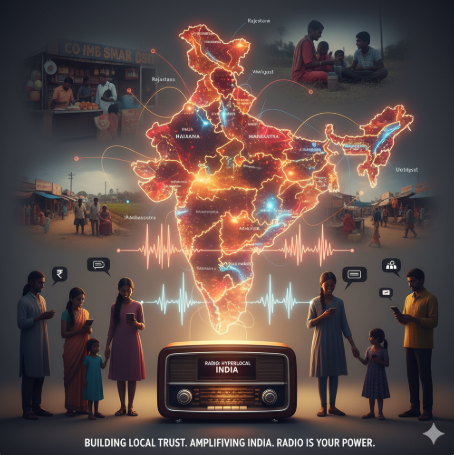The Radio Ads: Timeless Power of Sound in a Digital-First World
Imagine this: it’s 8:30 AM, traffic is crawling on Mumbai’s Western Express Highway. People are restless, scrolling through their phones, but one thing remains consistent—the radio is playing in almost every car. A cheerful RJ cracks a joke, a local business ad plays right after, and instantly the driver remembers a new café opening just a few kilometers away.
That’s the magic of radio advertising—personal, local, and impossible to ignore when you’re on the go.
In today’s world, where digital dominates the marketing conversation, many assume radio has taken a back seat. But the truth? Radio remains one of the most effective hyperlocal advertising tools, especially in India. It builds community, sparks conversations, and creates emotional resonance—all while being cost-effective and measurable.
This article will uncover why radio still creates strong local connections for brands, its ROI-driven advantages, and how businesses can strategically use it to amplify their marketing mix.
Why Radio Still Works in a Digital-First Era

1. Radio Ads Is Local by Nature
Unlike many media channels, radio is inherently community-driven. Whether you’re in Delhi, Bengaluru, or Lucknow, regional FM stations curate their playlists, ads, and shows to reflect local culture. For brands, this means direct access to an audience that trusts their local station like a neighbor.
2. Radio Ads Cut Through the Noise
Digital ads can be skipped, blocked, or scrolled past. Radio, however, commands attention naturally. While driving, cooking, or working, people absorb messages without distraction.
3. Emotional Resonance Through Voice & Music
Sound is powerful. A jingle, a catchy tagline, or even a familiar RJ’s voice creates memory hooks. Brands that use storytelling through audio build deeper, emotional bonds with listeners.
4. Radio + Digital = Hybrid Branding Power
Many FM channels are now live on mobile apps, YouTube, and podcasts. This means your radio ads don’t just stay on air—they extend into the digital ecosystem for amplified reach.
Real-World ROI of Radio Advertising
- Local Retail Stores – A clothing outlet in Pune saw footfalls increase by 35% during their end-of-season sale after running two weeks of FM ads.
- Restaurants & Cafés – Radio ads paired with discount codes helped a Hyderabad café track direct ROI with a 20% boost in new customers.
- Educational Institutes – Coaching centers use radio to reach parents in Tier-2 cities, seeing strong enrollment numbers.
- E-commerce Players – Even big players like Flipkart have used radio to penetrate regional markets, tapping into audiences less active on digital platforms.
Storytelling on Air: Making Radio Ads Fun Again
- RJs as Brand Advocates – Instead of a flat ad, imagine an RJ talking about your brand like a trusted friend. Listeners take those words more seriously.
- Catchy Jingles – Think of Nirma or Airtel—short, memorable tunes that live in people’s heads for decades.
- Localized Messaging – A taxi service ad in Chennai in Tamil, with cultural humor, will outperform a generic national ad.
Radio isn’t just advertising—it’s storytelling with sound that becomes part of people’s daily lives.
Why Brands Shouldn’t Ignore Radio

- Affordability: Radio campaigns are cost-effective compared to TV or large-scale OOH.
- Mass Reach: With FM penetration across 99% of India’s population, it reaches urban and rural alike.
- Trust Factor: People trust voices they hear daily. RJ endorsements drive conversions.
- Flexibility: Ads can be tailored for specific slots (like morning commute or evening drive time) for maximum impact.
Latest Trends in Radio Advertising
- Interactive Radio Ads – Listeners call in, answer questions, or engage live with brands.
- Podcast Partnerships – Extending radio into on-demand audio content.
- Branded RJ Mentions – Subtle storytelling instead of direct selling.
- Regional Language Campaigns – Stronger resonance in Tier-2 and Tier-3 cities.
- Radio + Social Media – Running contests where radio listeners engage online too.
FAQs on Radio Advertising
1. What is radio advertising?
Radio advertising is the promotion of products, services, or brands through FM/AM radio channels, often via jingles, spots, or RJ mentions.
2. Why is radio advertising still relevant?
Radio remains hyperlocal, affordable, and trusted by millions in India, especially where digital ads have less penetration.
3. How much does radio advertising cost in India?
Costs depend on station, city, and time slot. Small-city FM ads may start from ₹500–₹1,000 per 10-second spot, while metros are higher.
4. Which industries benefit the most from radio ads?
Retail, restaurants, education, real estate, and FMCG brands gain the most from localized campaigns.
5. Can radio ads be tracked for ROI?
Yes, via discount codes, call tracking, surveys, and monitoring spikes in store visits or inquiries.
6. Is radio advertising good for small businesses?
Absolutely. With affordable packages and local reach, radio is ideal for SMEs.
7. How is radio integrating with digital?
Stations stream live online, integrate ads with social media contests, and repurpose content into podcasts.
8. What is the future of radio advertising?
Radio is moving toward digital-first audio experiences, with interactive ads, localized content, and hybrid radio-digital campaigns.
Conclusion: Radio Still Rocks the Local Market
In a digital-first world, it’s easy to overlook radio. But for businesses aiming to build local trust, drive real-world ROI, and create emotional resonance, radio is still unmatched.
It doesn’t just broadcast—it connects communities, amplifies voices, and carries your brand into everyday conversations.
If you’re serious about hyperlocal growth in India, radio isn’t old-fashioned. It’s your hidden superpower.
Call to Action
📻 Ready to put your brand on air?
Whether you’re a local retailer, a growing startup, or a national brand looking to build stronger community connections, radio advertising is your best bet.
👉 Start your radio campaign today and let your brand be the voice everyone remembers.

